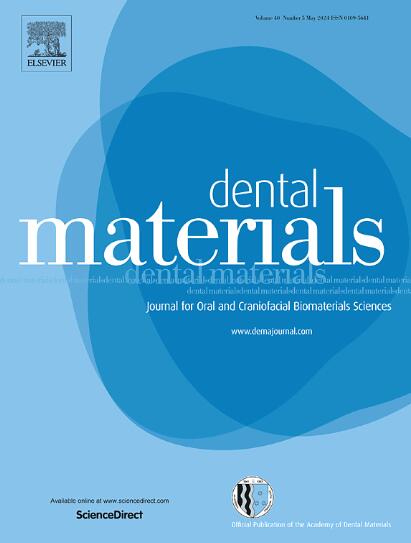使用 222 纳米 UV-C 光子在氧化锆上直接进行彩色印刷。
IF 4.6
1区 医学
Q1 DENTISTRY, ORAL SURGERY & MEDICINE
引用次数: 0
摘要
目标:方法:使用 222 nm UV-C 光(辐照度:1.870 mW/cm2)对 3Y-TZP 进行处理,处理时间为 15 分钟至 24 小时,在处理前后对 ΔE*、TP、晶体结构、表面形态、Sa、BFS 和生物活性进行研究。结果表明:222 纳米 UV-C 照射能将白色的 3Y-TZP 还原成牙齿的颜色。随着 ΔE* 的增加,TP 下降,照射时间越长,ΔE* 越高(对数关系),TP 越低。尽管诱导的光学变化容易褪色,但ΔE*、TP 和测试点之间的反比关系可以预测这一过程。经过处理的表面亲水性增强,同时出现了恢复现象。其他特性未因处理而改变:这是一项开创性的研究,证明了使用 222 纳米紫外线-C 在 3Y-TZP 上直接进行彩色印刷的可行性。在 3Y-TZP 的色心和 Eg 之间建立了新的关系,而诱导的光学变化在一定时间后趋于稳定,并可通过控制辐照时间高度预测。辐照只与电子激发和氧空位相关,不会导致其他性质发生任何变化。在临床实践中,可以开发出一种简单、安全且有前景的方法来获得令人满意的 3Y-TZP 颜色。本文章由计算机程序翻译,如有差异,请以英文原文为准。
Direct colour printing on zirconia using 222 nm UV-C photons
Objectives
To proof the feasibility of direct colour printing on 3Y-TZP using 222 nm UV-C through investigating the degree and durability of the colour changes, and testifying whether surface, mechanical and biological properties are influenced by the treatment.
Methods
222 nm UV-C light (Irradiance: 1.870 mW/cm2) was used to treat 3Y-TZP for durations from 15 min to 24 h. ΔE*, TP, crystalline structure, surface morphology, Sa, BFS and biological activities were investigated before and after irradiation. SPSS 28.0 was used for statistical analysis (α = 0.05).
Results
222 nm UV-C irradiation was capable to shade white 3Y-TZP into tooth colours. With the increase of ΔE*, TP decreased, such that the longer the irradiation time, the higher the ΔE* (logarithmic relationship) and lower the TP. Despite the induced optical changes being prone to fade, the process can be predicted by inversely proportional relationships between ΔE*, TP and the testing points. The treated surface exhibited enhanced hydrophilicity, while the recovery phenomenon was observed. Other properties were not altered by the treatment.
Significance
This is the seminal study demonstrating the feasibility of direct colour printing on 3Y-TZP using 222 nm UV-C. The new relationship between the colour centre and Eg of 3Y-TZP was established, whereas the induced optical changes were stabilised after a certain period and were highly predictable by controlling the irradiation periods. The irradiation was only correlated to the electron excitation and oxygen vacancies, and would not lead to any changes of other properties. A simple, safe and promising approach to achieve satisfactory colours on 3Y-TZP in clinical practice can be developed.
求助全文
通过发布文献求助,成功后即可免费获取论文全文。
去求助
来源期刊

Dental Materials
工程技术-材料科学:生物材料
CiteScore
9.80
自引率
10.00%
发文量
290
审稿时长
67 days
期刊介绍:
Dental Materials publishes original research, review articles, and short communications.
Academy of Dental Materials members click here to register for free access to Dental Materials online.
The principal aim of Dental Materials is to promote rapid communication of scientific information between academia, industry, and the dental practitioner. Original Manuscripts on clinical and laboratory research of basic and applied character which focus on the properties or performance of dental materials or the reaction of host tissues to materials are given priority publication. Other acceptable topics include application technology in clinical dentistry and dental laboratory technology.
Comprehensive reviews and editorial commentaries on pertinent subjects will be considered.
 求助内容:
求助内容: 应助结果提醒方式:
应助结果提醒方式:


